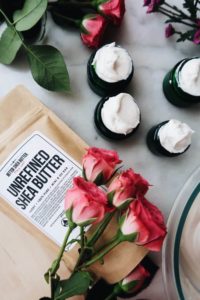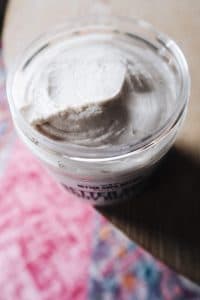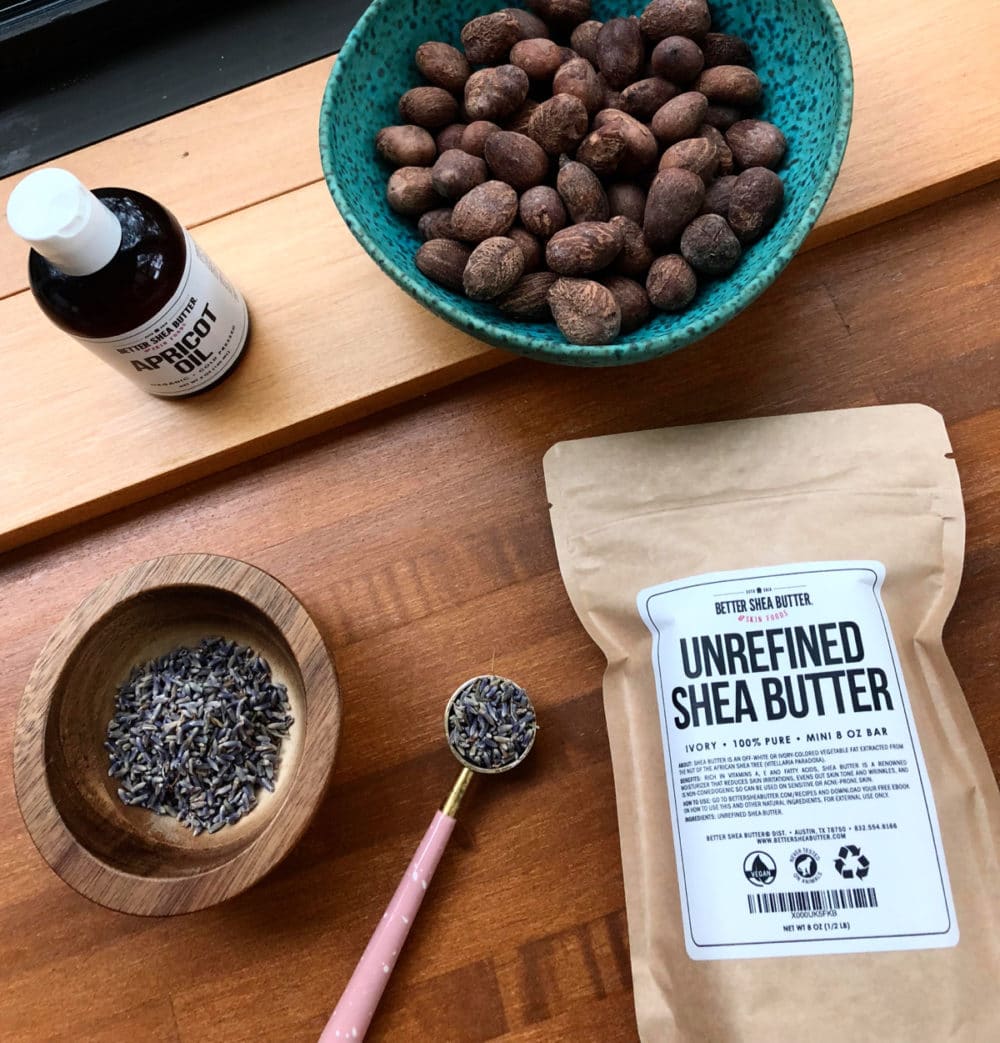Shea Butter is widely known throughout the world for its unique deep-moisturizing qualities, its ability to soothe eczema and many other frustrating skin conditions. With this article, we hope to answer your Shea Butter frequently asked questions in detail.
 What is Shea Butter?
What is Shea Butter?
To put it simply, Shea Butter is a vegetable fat extracted from the nut of the African Karite tree, also called the Shea tree. Shea Butter, as a beauty product has been traced back to the Egyptian Queen Cleopatra around 50 BC (that’s more than 2000 years ago!), and it is, to this day, the most moisturizing, rich and wonderful cosmetic butter you can find.
You can find two types of shea butter available on the market for use as a cosmetic: Unrefined (or Raw Shea), and Refined or Ultra Refined.
Unrefined or Raw Shea Butter is a butter that has not been processed with any chemicals. It is mechanically extracted and filtered to remove particles from the shea nut that remain in the butter from the first extraction process. By mechanically filtering it the butter then retains all of its vitamins and healing properties.
Unrefined shea butter can vary in shades of ivory or gold, and it has a slightly smokey and nutty scent that is caused by the roasting process it goes through. Unrefined Shea Butter will feed and heal your skin, it will nourish it and will make a big difference in your beauty routine.
Refined or Ultra refined shea butter is white and unscented. This is achieved by using a variety of solvents, bleaches and other chemicals that strip the shea butter down to a simple, white butter. While this butter is easy to work with and still works as a skin moisturizer, it has lost most of its original vitamins and antioxidants. So to the question of which one is best, the answer is up to you, (hint: Cleopatra did not use refined shea butter…)
Where Does it Come From?
Shea trees (Karite Trees) with the botanical name, Vitellaria Paradoxa, grow wild in the so-called “shea belt”, a narrow, horizontal section of fertile soils that stretch from West Africa to East Africa. There are two common species of the shea tree: Vitellaria Paradoxa, typical of Ghana, and Vitellaria Nilotica found in Nigeria and surrounding areas.
Due to the unrest of many countries where shea butter originates, it is sometimes difficult to procure high-quality shea butter. We at Better Shea Butter have worked hard over the years to source grade A, high quality, fair trade shea butter from women co-ops in Ghana.
How is Shea Butter Made?
Extracting this rich butter from the shea nuts is an extensive and laborious process, done according to century-old traditions and, in the case of our butters, made almost exclusively by women in Ghana who do this for a living. This is why shea butter is also referred to as “Women’s Gold” – it provides millions of women in Africa employment and income.
Here are the steps taken to produce unrefined shea butter:
First, the shell of the fruit is cracked to access the center of the nut, the cracked nuts are then washed and left dry so that all the moisture is removed. The nuts are then pounded so that they become small and fine pieces. Next, the small pieces are roasted down to a brown paste, similar to chocolate. Once this has been done, water is added to the brown paste and a long stirring process is started. With this complete the paste is washed with distilled water to purify it. The paste is then heated over fire. As it heats the fat rises to the top and separates from the paste. This fat is then skimmed from the top and is put aside to solidify. Once solidified it is then shea butter as you receive it!
Does Shea Butter Go Bad?
Shea Butter is a very resilient butter, with a long shelf life of 3-4 years from the date of production as long as it is stored properly. We keep on the safe side and guarantee a 2-year shelf life on our Unrefined Shea so you get fresh butter and do not risk using it when it goes bad.
There are a couple ways shea butter can go bad prematurely:
- Natural oxidation. This is where light and heat affect the butter (this can happen to any butters and oils as well) and the chemical structure in the butter changes, the butter starts to smell rancid and acidic.
- The butter gets contaminated with water and, without the presence of preservatives, mold and yeast start to grow and the butter is spoiled.
To ensure your Unrefined Shea Butter has the longest shelf life, keep it in a cool place, uncontaminated in its original container, or in a glass jar with a lid.
Is Shea Butter Edible?
In some African countries, raw shea butter is used in food preparation just like animal butter or vegetable oil is used in cooking in the West and other countries.
That said, all shea butter that is currently sold in the US and other parts of the world is not for consumption but it is sold as a “skin food”, meaning that you can apply it to your skin and it will feed it vitamins and antioxidants that your skin needs to stay healthy.
We believe that this practice is more out of habit than anything else – it is possible that, given the right testing and pending it meets the FDA standards, shea butter may one day be sold and marketed in non-African countries as a food item.
What Is It Good For?
Shea butter is an incredible skin moisturizer and skin problem solver. From using it in a body moisturizer or lip balm and even as an ingredient in soap, the possibilities seem endless. There are many benefits, and this is why using shea butter in a variety of things is a good idea.
It is good for skin smoothing and relieving irritations such as eczema or other rashes. Check out what customer Margaret told us about her experience using shea butter for eczema.
Despite being a fat butter, it is non-comedogenic, so it will not clog pores. If you suffer from acne or have occasional breakouts, read how shea butter can help acne sufferers.
It aids the body’s natural collagen production which in turn will stop your skin from becoming dry. Thanks to the combination of fatty acids and vitamins, shea butter is very nourishing for the skin.
How Do You Use It On Your Face?
You can use unrefined shea butter as a stand-alone face moisturizer by breaking off a pea size portion of shea, then rubbing it between your fingers to let it melt. Then you should gently massage it into your skin, starting with your cheeks and moving around your face. The reason that you should do it this way is because the natural heat from rubbing it between your fingers breaks down the shea butter into an oil form. This makes it easier to spread on your face, and the skin will absorb it faster. Keep in mind that this is a pure butter and a little goes a long way – just use enough that will get absorbed on your skin, and you can pat dry any excess as needed.
Another great way to use shea butter on your face is to melt a small amount with other ingredients of your choice such as Apricot Oil, Rosehip Seed Oil, Jojoba Oil or Almond Oil and blend them to make a nice face moisturizer.
You use a ratio of 50% shea butter and 50% oil, work them together with a utensil until a nice lotion is formed, and then add a few drops of essential oils to add a natural scent and to experience additional therapeutic qualities of essential oils.
Does It Clog Pores?
Although shea butter is 100% fat, it will surprise you to find out that shea butter is one of the few cosmetic butters that do not clog pores.
On the contrary, unrefined shea butter helps heal skin conditions caused by clogged pores such as acne. It helps moisturize and reduces skin irritation.
How to whip it
Here is how you melt and whip shea to perfection. If you do this right, the air bubbles you introduce in the body butter while whipping will stay, resulting in a stable fluffy structure. Unless of course, your body butter melts to a liquid due to hot weather, then the whipped effect will be gone – welcome to the world of truly natural skin care.
- Slowly melt the shea butter in a double boiler (bain-marie in French or bagnomaria in Italian) and melt it on low heat. A burned butter is never a good idea, so slow and steady is the way to go
- Turn off the heat and remove the butter from the burner. At this stage, you can add carrier oils and vitamin E, but it’s still too hot to add essential oils
- Let it cool off to room temperature either by setting aside or by placing your container in a bowl with ice to speed up the process
- Stir it occasionally while you are waiting for it to cool off close to room temperature, or about 75 F (23 C)
- Add the essential oils if applicable
- WHIP IT! That’s right, you whip it while it’s still liquid. I am not sure on the science behind it, but if you skip this step, it won’t turn out as nice
- Put it in the fridge until it’s completely solid
- Take it out of the fridge and let it soften enough to be able to WHIP IT AGAIN
- And you’re done!
- Now you can scoop the shea in your final containers, or you can pour the whipped butter in a ziplock bag, cut a corner at the end of it, then squeeze into your jars.
 How To Make Shea Butter Lotion
How To Make Shea Butter Lotion
To make shea butter lotion, all you will need is shea butter, coconut oil, almond oil, and any essential oils that you want to use. Here are the steps to making the lotion:
- Melt the shea butter and the coconut oil together in a double boiler and leave it to cool for about 30 minutes.
- Stir in the almond oil and any essential oils you wish to use.
- Wait until you start to see the oil partially solidify, then put the mixture into a clean container, seal with a lid and you are ready to enjoy your lotion!
When using your shea butter lotion be sure to not leave the container exposed to sunlight and always reseal with the lid after each use for longer preservation.
How to Make Shea Butter Soap
There are two general ways to approach soap making:
- From scratch. Here you use lye as the key ingredient for your saponification process, then add fats, butters, oils, and all other ingredients. This is called Cold Process Soap. It takes a few hours and requires quite some practice.
- You can use a soap base that you melt and personalize with colors, dry ingredients (dry flowers, oatmeal, clay, etc.) and most importantly your nourishing ingredients like Shea butter and carrier oils. This is called Melt and Pour Soap.
In this article, we will just cover the fastest and easiest way to make shea butter soap utilizing the Melt and Pour Soap. Simply use 8 ounces of a Shea Butter Melt and Pour Soap base, add 1 ounce of shea butter, melt them together until liquid, then add your color and fragrance as needed. Pour into molds and let the shea butter soap solidify completely before using.
Ready to order?
We have a few options if you want to order our fresh, unrefined, pure Shea Butter:
a. Get a sample of our top 3 butters – Shea, Mango and Cocoa – and compare them all.
b. Get a Shea Butter Mini bar and try it in a few recipes to get familiar with it without a big commitment.
c. Get our classic 1LB Shea Butter bar and have enough for many projects. Shea Butter will last you more than 12 months so you are safe to invest in this.
d. If you are launching or already have an existing homemade skin care business, choose our bulk 5 LB or 10 LB sizes of Unrefined Shea Butter and you will save a ton!


